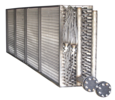HVAC Coil Measurement Starter Guide

After doing a couple of field measurements for replacement coils this week, I noticed that many technicians and installers think measuring a coil is complicated. I'm going to try to debunk that myth with a quick primer.
You'll need these hard to find tools:
For the paper part I'd recommend that you start with one of our
The following parameters are generally sufficient to get a price or quote. There are definitely more considerations, but we'll save that for another post.
This one should be easy. What kind of coil is it? Normal choices are: hot water, chilled water, steam, evaporator (which is the cooling coil in an air-conditioner), and condenser (the outdoor coil for an air-condtioner).
Tube diameter is the size of the tubes running through the coil. Typical sizes are: 3/8" (0.375 inch), 1/2" (0.5 inch), 5/8" (0.625 inch), and 1" (1.0 inch).
Fin Height is the height of the fins (obviously), measured in the same direction as the header.Fin Length is the length of the fins (again... obviously), measured in the same direction as the tubes.
The number of rows is an indication of how deep the coil fins are. It's easiest to check this by looking at the non-headered (or return) side. Ignore the return bends. What you need to count is how many rows of tubes there are. Some people understand this better by counting the number of rows of holes in the sheet metal.
This is just a measurement of how close the fins are to each other. Just count the number of fins in any 1" (1.0 inch) segment of fins. You can count 10 fins in 1" on this one, thus 10 fpi.
Each coil has an inlet and outlet. You'll need to know the diameter of each. Just measure the diameter of the tube or threaded connection that the fluid enters and exits through. This is also called supply and return connection size.
So, hopefully that didn't seem too bad. Granted, these are the basics, but they are the core information that any coil manufacturer would need to price or quote a coil.
I hope that next time you repair or replace a coil, you find this helpful.
